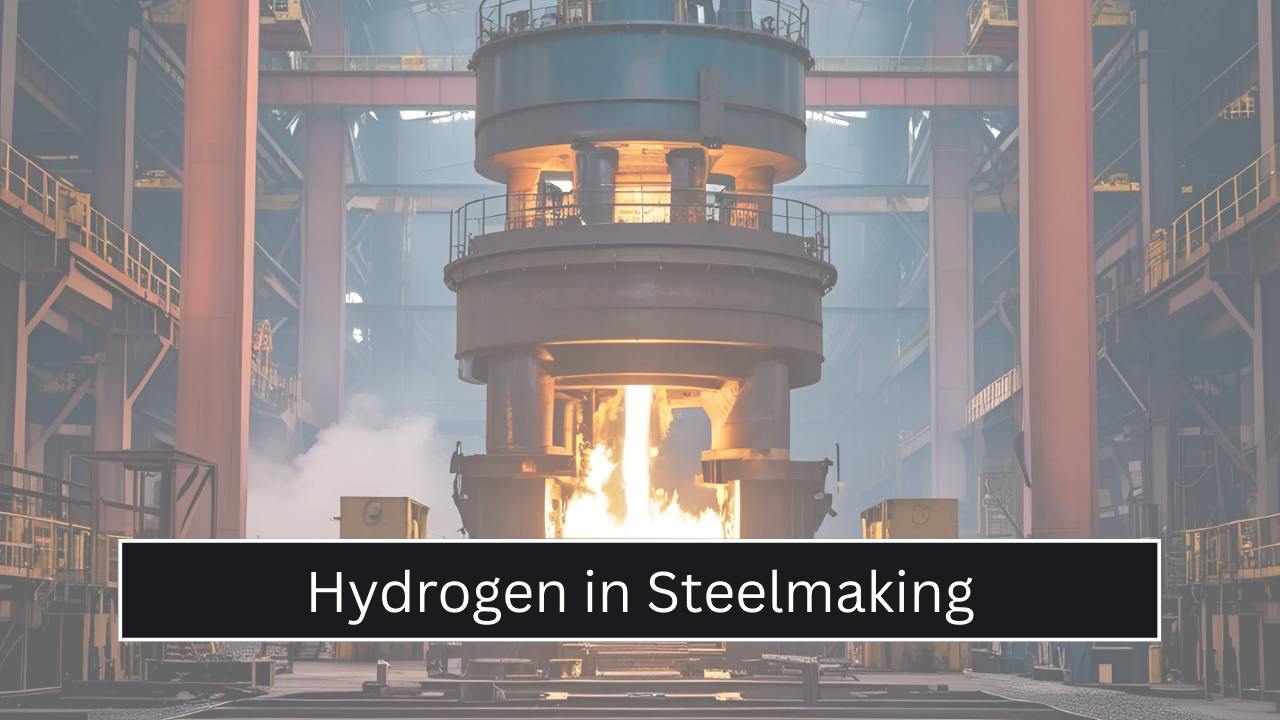Steel production remains one of the most carbon-intensive industrial processes in the world. Traditional methods, especially those relying on blast furnaces and coke ovens, contribute significantly to global greenhouse gas emissions. As climate change intensifies and sustainability becomes a global priority, the steel industry faces mounting pressure to decarbonize its operations. Among various innovative approaches, hydrogen-based steelmaking has emerged as a potential game changer in achieving net-zero emissions.
Hydrogen, particularly green hydrogen produced through electrolysis using renewable energy, offers a clean alternative to fossil fuels in steel production. This transition not only promises to reduce carbon dioxide emissions drastically but also reshapes the future of industrial manufacturing.
Current Steelmaking Process and Its Environmental Impact
Conventional steelmaking primarily relies on the blast furnace-basic oxygen furnace (BF-BOF) route, which uses coke (derived from coal) to reduce iron ore into molten iron. This process releases large amounts of carbon dioxide, making the steel industry responsible for around 7-9% of global CO₂ emissions.
Traditional vs Hydrogen-based Steelmaking
| Process Aspect | Traditional Steelmaking (BF-BOF) | Hydrogen-based Steelmaking (DRI-H2) |
|---|---|---|
| Main Reducing Agent | Coke (coal-based) | Hydrogen (preferably green) |
| Major Emission | Carbon dioxide (CO₂) | Water vapor (H₂O) |
| Energy Source | Fossil fuels | Renewable electricity |
| Carbon Emission Intensity | High | Very low or zero |
| Global Adoption | Widely used | Emerging/Scaling |
The need to drastically cut emissions makes the transition to hydrogen an attractive and increasingly necessary innovation.
Hydrogen as a Clean Reducing Agent
In hydrogen-based steelmaking, iron ore is reduced using hydrogen instead of carbon. This process is known as Direct Reduction of Iron using Hydrogen (H2-DRI). When hydrogen reacts with iron ore (Fe₂O₃), the chemical reaction forms pure iron and water vapor, instead of carbon dioxide.
Reaction:
Fe2O3+3H2→2Fe+3H2OFe_2O_3 + 3H_2 \rightarrow 2Fe + 3H_2OFe2O3+3H2→2Fe+3H2O
This chemical transformation eliminates direct carbon emissions and plays a pivotal role in green steel production.
Types of Hydrogen and Their Relevance
Hydrogen used in industrial processes is categorized based on its production method:
Types of Hydrogen
| Type | Production Method | Emissions | Relevance in Steelmaking |
|---|---|---|---|
| Grey Hydrogen | From natural gas (steam methane reforming) | High CO₂ emissions | Not suitable for decarbonization |
| Blue Hydrogen | Grey hydrogen + carbon capture & storage (CCS) | Reduced CO₂ emissions | Transitional solution |
| Green Hydrogen | Electrolysis using renewable energy | Zero emissions | Ideal for green steel |
Only green hydrogen can truly enable carbon-free steelmaking, though it currently remains the most expensive form due to energy and infrastructure costs.
Benefits of Hydrogen-Based Steelmaking
The adoption of hydrogen in steelmaking presents a range of benefits:
- Carbon Neutrality: Replaces carbon-intensive coke with hydrogen, dramatically cutting emissions.
- Sustainable Future: Aligns steel manufacturing with global net-zero targets.
- Water Vapor Emissions: Outputs steam instead of CO₂, making it environmentally cleaner.
- Energy Transition Synergy: Utilizes renewable energy, enhancing the value of solar, wind, and hydroelectric power.
Benefits Overview
| Advantage | Impact on Industry |
|---|---|
| Reduced Carbon Emissions | Significant drop in direct CO₂ emissions |
| Compliance with Regulations | Supports environmental policy and ESG goals |
| Future Market Positioning | Positions companies as green leaders |
| Integration with Renewables | Promotes large-scale use of green energy |
| Innovation Opportunities | Stimulates technology advancement in clean metallurgy |
Challenges and Limitations
While promising, hydrogen steelmaking faces several hurdles:
- High Cost of Green Hydrogen: Electrolysis remains energy-intensive and costly.
- Infrastructure Requirements: New hydrogen pipelines, storage, and safety systems are needed.
- Technical Readiness: Industrial-scale hydrogen furnaces and DRI units are still in development.
- Intermittent Energy Supply: Dependence on renewable energy can lead to supply instability.
Key Challenges in Hydrogen Steelmaking
| Challenge | Description |
|---|---|
| Cost | Green hydrogen is 2-4 times more expensive than fossil fuels |
| Storage & Transport | Hydrogen is highly flammable and needs special infrastructure |
| Technology Readiness | Full-scale deployment is still in pilot or trial stages |
| Renewable Energy Demand | Requires vast amounts of clean electricity |
| Global Scaling Timeline | Widespread use likely by 2030s or later |
Global Adoption and Industry Initiatives
Several countries and steel producers have started pilot projects to test and scale hydrogen steelmaking:
- Sweden’s HYBRIT Project: A partnership between SSAB, LKAB, and Vattenfall, aiming to deliver fossil-free steel by 2026.
- Germany’s Salzgitter AG: Initiated a hydrogen-based steel trial using electrolyzers powered by renewables.
- India and China: Exploring hydrogen integration to reduce their heavy industrial carbon footprints.
- ArcelorMittal: Committing billions to transition its facilities in Europe towards hydrogen DRI.
Notable Hydrogen Steelmaking Projects
| Project/Company | Country | Key Goal | Timeline |
|---|---|---|---|
| HYBRIT (SSAB) | Sweden | Fossil-free steel production | By 2026 |
| Salzgitter Low CO₂ | Germany | Green hydrogen-powered steel | Pilot phase |
| ArcelorMittal | Europe/Global | Hydrogen-based plants across EU | By 2030 |
| POSCO Hydrogen Plans | South Korea | Green hydrogen production and integration | By 2035 |
| Tata Steel | India | Evaluating hydrogen in DRI processes | Ongoing |
Economic and Policy Support
Government backing is essential for scaling hydrogen use in steelmaking. Policy mechanisms can include:
- Subsidies and Tax Incentives: To lower the cost of electrolyzers and renewable energy.
- Carbon Pricing: Making carbon-intensive steel more expensive encourages greener alternatives.
- Public-Private Partnerships: Accelerate pilot projects and infrastructure development.
- Hydrogen Roadmaps: Countries like Germany, Japan, and India have national strategies to scale hydrogen economies.
Future Outlook
Hydrogen is rapidly evolving from a conceptual solution to a realistic pathway for decarbonizing steelmaking. With the right combination of policy support, technological advancement, and investment, hydrogen-based steel could become the standard by 2040 or earlier.
Developing nations with abundant sunlight or wind, such as India, Australia, and parts of Africa, can become green hydrogen hubs, supplying cleaner alternatives to global markets. If scaled properly, hydrogen has the potential to decarbonize one of the most emission-heavy industries and contribute meaningfully to global climate goals.
Moving Forward
Hydrogen presents a revolutionary opportunity to reshape steelmaking into a cleaner, sustainable process. While challenges around cost and infrastructure remain, strong momentum from governments, industries, and research institutions is rapidly closing these gaps. The shift to hydrogen in steelmaking is not just a technological change—it’s a strategic move toward a decarbonized industrial future.
The race is now on to make hydrogen not just a possibility, but the backbone of green steel production worldwide.

